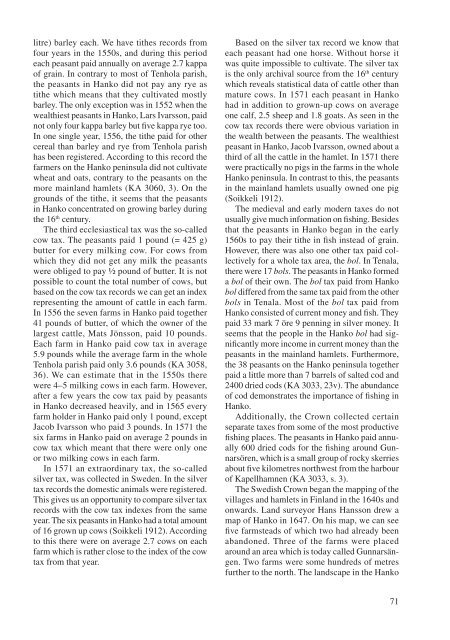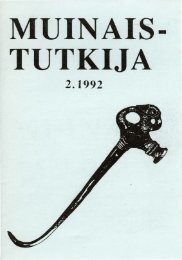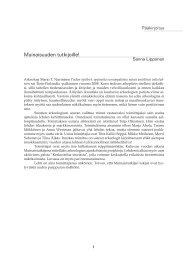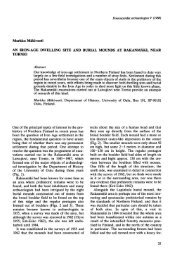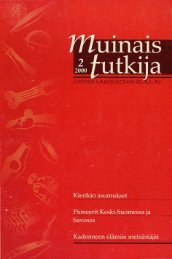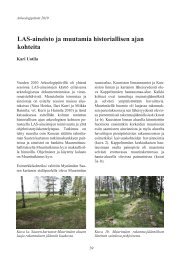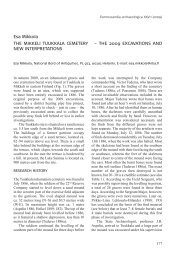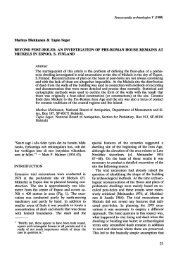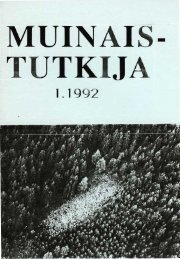Henrik Jansson, Georg Haggrén, Kristiina Mannermaa & Tanja ...
Henrik Jansson, Georg Haggrén, Kristiina Mannermaa & Tanja ...
Henrik Jansson, Georg Haggrén, Kristiina Mannermaa & Tanja ...
You also want an ePaper? Increase the reach of your titles
YUMPU automatically turns print PDFs into web optimized ePapers that Google loves.
litre) barley each. We have tithes records fromfour years in the 1550s, and during this periodeach peasant paid annually on average 2.7 kappaof grain. In contrary to most of Tenhola parish,the peasants in Hanko did not pay any rye astithe which means that they cultivated mostlybarley. The only exception was in 1552 when thewealthiest peasants in Hanko, Lars Ivarsson, paidnot only four kappa barley but five kappa rye too.In one single year, 1556, the tithe paid for othercereal than barley and rye from Tenhola parishhas been registered. According to this record thefarmers on the Hanko peninsula did not cultivatewheat and oats, contrary to the peasants on themore mainland hamlets (KA 3060, 3). On thegrounds of the tithe, it seems that the peasantsin Hanko concentrated on growing barley duringthe 16 th century.The third ecclesiastical tax was the so-calledcow tax. The peasants paid 1 pound (= 425 g)butter for every milking cow. For cows fromwhich they did not get any milk the peasantswere obliged to pay ½ pound of butter. It is notpossible to count the total number of cows, butbased on the cow tax records we can get an indexrepresenting the amount of cattle in each farm.In 1556 the seven farms in Hanko paid together41 pounds of butter, of which the owner of thelargest cattle, Mats Jönsson, paid 10 pounds.Each farm in Hanko paid cow tax in average5.9 pounds while the average farm in the wholeTenhola parish paid only 3.6 pounds (KA 3058,36). We can estimate that in the 1550s therewere 4–5 milking cows in each farm. However,after a few years the cow tax paid by peasantsin Hanko decreased heavily, and in 1565 everyfarm holder in Hanko paid only 1 pound, exceptJacob Ivarsson who paid 3 pounds. In 1571 thesix farms in Hanko paid on average 2 pounds incow tax which meant that there were only oneor two milking cows in each farm.In 1571 an extraordinary tax, the so-calledsilver tax, was collected in Sweden. In the silvertax records the domestic animals were registered.This gives us an opportunity to compare silver taxrecords with the cow tax indexes from the sameyear. The six peasants in Hanko had a total amountof 16 grown up cows (Soikkeli 1912). Accordingto this there were on average 2.7 cows on eachfarm which is rather close to the index of the cowtax from that year.Based on the silver tax record we know thateach peasant had one horse. Without horse itwas quite impossible to cultivate. The silver taxis the only archival source from the 16 th centurywhich reveals statistical data of cattle other thanmature cows. In 1571 each peasant in Hankohad in addition to grown-up cows on averageone calf, 2.5 sheep and 1.8 goats. As seen in thecow tax records there were obvious variation inthe wealth between the peasants. The wealthiestpeasant in Hanko, Jacob Ivarsson, owned about athird of all the cattle in the hamlet. In 1571 therewere practically no pigs in the farms in the wholeHanko peninsula. In contrast to this, the peasantsin the mainland hamlets usually owned one pig(Soikkeli 1912).The medieval and early modern taxes do notusually give much information on fishing. Besidesthat the peasants in Hanko began in the early1560s to pay their tithe in fish instead of grain.However, there was also one other tax paid collectivelyfor a whole tax area, the bol. In Tenala,there were 17 bols. The peasants in Hanko formeda bol of their own. The bol tax paid from Hankobol differed from the same tax paid from the otherbols in Tenala. Most of the bol tax paid fromHanko consisted of current money and fish. Theypaid 33 mark 7 öre 9 penning in silver money. Itseems that the people in the Hanko bol had significantlymore income in current money than thepeasants in the mainland hamlets. Furthermore,the 38 peasants on the Hanko peninsula togetherpaid a little more than 7 barrels of salted cod and2400 dried cods (KA 3033, 23v). The abundanceof cod demonstrates the importance of fishing inHanko.Additionally, the Crown collected certainseparate taxes from some of the most productivefishing places. The peasants in Hanko paid annually600 dried cods for the fishing around Gunnarsören,which is a small group of rocky skerriesabout five kilometres northwest from the harbourof Kapellhamnen (KA 3033, s. 3).The Swedish Crown began the mapping of thevillages and hamlets in Finland in the 1640s andonwards. Land surveyor Hans Hansson drew amap of Hanko in 1647. On his map, we can seefive farmsteads of which two had already beenabandoned. Three of the farms were placedaround an area which is today called Gunnarsängen.Two farms were some hundreds of metresfurther to the north. The landscape in the Hanko71


